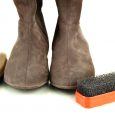 You have a lot to keep track of as a runner – from proper stride, to split times, to amount of mileage, to proper hydration, to, well, the list could go on for nearly as long as it takes to run a 5K. But if there’s one thing you must never take for granted, it’s your shoes.
You have a lot to keep track of as a runner – from proper stride, to split times, to amount of mileage, to proper hydration, to, well, the list could go on for nearly as long as it takes to run a 5K. But if there’s one thing you must never take for granted, it’s your shoes.
The right shoes to a runner are like the right tools for a carpenter. Or, like the right knives for a sushi chef. You get the picture. Grab the wrong tool and the job isn’t done correctly. Grab the wrong pair of running shoes off the shelf while calling them ‘good enough’ can be a mistake your feet will for which your feet will never forgive you.
And it all comes down to the fit. They might be that pair of running shoes you’ve researched and saved money for, but it they don’t fit, you’ve wasted both time and cash. Maybe you could still use them to mow the lawn. But, let’s face it, those are pretty expensive yard shoes.
So how should running shoes fit, properly? We’re glad you asked.
15 Things to Consider When Looking For The Best-Fitting Running Shoes
1. The Fit, The Fit, The Fit
Again, the fit is the age-old secret to finding the right running shoes. Sure, other factors have to be considered as well, but without the right fit, you’ll feel the strain physically, mentally and performance-wise. Again, you may end up with the coolest lawn-mowing shoes in your neighborhood, but those shoes had the potential to be so much more.
So when you explore exactly how should running shoes fit, there are many things to keep in mind:
2. Shoe Brands And How They Fit
Have we said yet that fit is important? Well, it takes on even greater importance when you consider that the greatest difference between brands isn’t cushioning or durability, but fit. Every company builds it footwear on different lasts – or shoe form – which is why one brand may fit you better than others. Plus, a size 9 in a Mizuno might not be the same as a size 9 in an Asics.
3. Your Feet
Let your feet help determine which shoe is right for you. If you have a wide foot, don’t try to wedge it into a shoe that has a narrow fit with the hope that it will get looser with age (nope, it won’t). Also remember, your feet spread and lengthen over time, so last year’s size might not be this year’s size.
Something else to remember: Your feet aren’t necessarily the same size and may even vary by as much as a full size. Fit the larger foot, and if there is a significant size difference between the two, buy two different size shoes.
4. Dress Shoe Size Vs. Running Shoe Size
Those great looking shoes you wore to work today could very well be a different size than the shoes you’ll hit the track or trail with later. Why? Because running shoes tend to run (at least half a size) smaller than dress shoes.
5. Bring Your Socks
Not the socks you wore all day at the office, mind you, but the socks you run in. Running socks are typically thicker than dress socks. So bring your running socks with you when you go running shoe shopping.
Now, The Details
 Let’s get down to the brass tacks of how should running shoes fit. Once you’ve selected a couple of finalists (which is always advisable), here’s what you should consider when it comes to the best fit.
Let’s get down to the brass tacks of how should running shoes fit. Once you’ve selected a couple of finalists (which is always advisable), here’s what you should consider when it comes to the best fit.
6. Heel Area
The shoe should fit snugly enough that your heel doesn’t slip in the rearfoot portion of the shoe. If you wear orthotics, it’s important to insert them during the fitting because they can affect the way the heel fits.
7. Toe Box
It’s been said of regular shoes that your toes should have enough room to play a Mozart symphony. While having the capability to knock out Symphony no. 31 (Paris) isn’t a requirement for how should running shoes fit, you get the picture. The general rule is: leave about a thumbnail’s width of room between your longest toe and the end of the shoe. Also, your feet will swell on long, hot runs, which is why the proper length/toe room is vital.
8. Midfoot
Look for a snug, secure foot under your arch. Runners – and non-runners, for that matter – have different types of arches; just be certain that the shoe doesn’t pinch or bind at this part of the foot.
9. Uppers
This part of the running shoe is typically made of a lightweight mesh which secures the foot in the shoe. You’ll want a snug fit here, but not too tight so that you feel pinching Or, too loose of a fit that you feel movement in your foot. Find the right balance.
10. Flex It
Like size, flexibility differs from shoe brand to shoe brand. The important thing to remember is that the forefoot should flex at about the same point that your foot flexes.
We’ve covered some of the sizing basics, which are crucial to finding the right fit. But in your quest to find the best running shoe for you, here are some more helpful hints:
11. Don’t rush
Leave enough time that you can properly measure your feet and try on different shoes. If you fly through it and grab the first pair that seems decent, you may pay the price later (and your feet will disown you).
12. Buy from the experts
If possible, always buy from a running shop where the employees are experienced in fitting running shoes. Most of them are runners, so they’ll know exactly what you should be looking for.
13. Give them plenty of information
Tell the salesperson – if he or she doesn’t ask – about what type of running you do, how often, and what type of surfaces you typically run on. Knowledge, as they say, is power, or at the least, will help you have a better running experience.
14. Don’t buy on hope
In other words, don’t buy a pair of running shoes that aren’t that comfortable in the store with the false hope that they will feel better after you ‘break them in.’ Never a good idea.
15. Shop later in the day
Our feet swell as the day goes on. It’s always helpful to shop for new shoes when your feet are at their everyday size, so to speak.
When it comes to how should running shoes fit, you need to take careful consideration of many factors – from length, to width, to flexibility and, of course, comfort. But knowing that the fit is the most important part of your final decision of what pair you’ll buy, will help you avoid injury and enjoy running a whole lot more.














